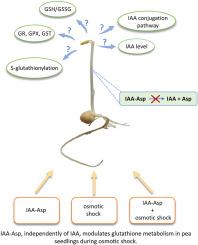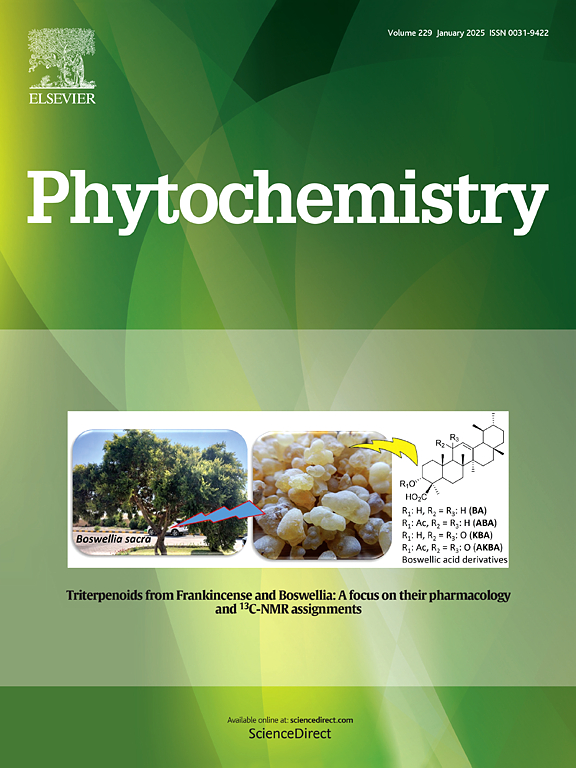采用生化和蛋白质组学方法研究渗透休克期间 IAA-天门冬氨酸对豌豆(Pisum sativum L.)幼苗的影响。
IF 3.2
2区 生物学
Q2 BIOCHEMISTRY & MOLECULAR BIOLOGY
引用次数: 0
摘要
渗透休克是高盐或干旱作用的第一步,涉及植物对这些不利条件做出反应过程中的生化和分子变化。吲哚-3-乙酰-天冬氨酸(IAA-aspartate,IAA-Asp)是豌豆(Pisum sativum L.)组织中主要的辅助素酰胺共轭物。尽管 IAA-Asp 作用的确切分子机制尚不清楚,但在生理和胁迫条件下,人们观察到这种共轭物具有不依赖于吲哚-3-乙酸(IAA)的生物活性。在这项工作中,我们研究了单独使用 IAA-Asp 以及与 NaCl 或聚乙二醇(PEG)(渗透休克)结合使用 IAA-Asp 对还原/氧化谷胱甘肽(GSH/GSSG)比率、谷胱甘肽浓度调节酶活性、蛋白质 S-谷胱甘肽化和 IAA 平衡的影响。在豌豆幼苗中,我们没有观察到 IAA-Asp 被水解为 IAA,这与其他结果一起表明,IAA-Asp 可独立于 IAA 调节植物对非生物刺激的反应。此外,尽管 IAA-Asp 对负责 IAA 共轭的酶有影响,但这种植物激素水平没有明显变化。此外,用 IAA-Asp 处理植物 3 小时会提高谷胱甘肽还原酶(GR)的活性,这与 GSH/GSSG 比率升高有关。相反,用 IAA-Asp 培养更长时间(48 小时)后,GSH/GSSG 比率降低,谷胱甘肽过氧化物酶(GPX)的活性增加。在盐处理过程中,IAA-Asp 会降低 GR 活性,但不会影响 GSH/GSSG 比率。同样,在用 PEG 培养植物时,IAA-Asp 不会改变 GSH/GSSG 比率,但会提高谷胱甘肽 S 转移酶(GST)的活性。我们还分析了 IAA-Asp 对豌豆蛋白质 S-谷氨酰化的影响。用 IAA-Asp、PEG 或 IAA-Asp 与 PEG 结合处理植物后,观察到热休克 70 kDa 蛋白(HSP70)的 S-谷胱甘肽化增加。蛋白质组分析还显示,IAA-Asp 会减少植物与 PEG 培养期间脂氧合酶的 S-谷胱甘肽化。因此,我们认为 IAA-Asp 可调节豌豆在氧化胁迫和正常生理条件下的氧化还原状态。本文章由计算机程序翻译,如有差异,请以英文原文为准。

Biochemical and proteomic approaches to investigating effects of IAA-aspartate in pea (Pisum sativum L.) seedlings during osmotic shock
Osmotic shock is the first step of high salt or drought action that involves biochemical and molecular changes during plant response to these unfavorable conditions. Indole-3-acetyl-aspartate (IAA-aspartate, IAA-Asp) is the main amide conjugate of auxin in pea (Pisum sativum L.) tissues. Although the exact molecular mechanism of the IAA-Asp action is unknown, this conjugate's indole-3-acetic acid (IAA)-independent biological activity has been observed during physiological and stress conditions. In this work, we investigated the effect of IAA-Asp alone, as well as in combination with NaCl or polyethylene glycol (PEG) (osmotic shock) on reduced/oxidized glutathione (GSH/GSSG) ratio, activities of enzymes modulating glutathione concentration, protein S-glutathionylation, and IAA homeostasis. We did not observe the hydrolysis of IAA-Asp to IAA in pea seedlings, which, together with other results, suggests that IAA-Asp modulates plant response to abiotic stimuli independently of IAA. Moreover, despite the effect of IAA-Asp on the enzymes responsible for IAA conjugation, no changes in this phytohormone level were visible. Furthermore, 3h plant treatment with IAA-Asp increased the activity of glutathione reductase (GR), which correlates with an elevated GSH/GSSG ratio. On the contrary, more extended (48h) incubation with IAA-Asp diminished the GSH/GSSG ratio and increased the activity of glutathione peroxidase (GPX). IAA-Asp reduced GR activity during salt treatment but did not affect the GSH/GSSG ratio. Similarly, under plant incubation with PEG, IAA-Asp did not change the GSH/GSSG ratio but increased glutathione S-transferase (GST) activity. We also analyzed the effect of IAA-Asp on pea protein S-glutathionylation. Increased S-glutathionylation of heat shock 70 kDa protein (HSP70) was observed after plant treatment with IAA-Asp, PEG, or IAA-Asp combined with PEG. The proteomic analysis also revealed that IAA-Asp diminished S-glutathionylation of lipoxygenase during plant incubation with PEG. Thus, we suggest that IAA-Asp modulates redox status in pea during oxidative stress and under normal physiological conditions.
求助全文
通过发布文献求助,成功后即可免费获取论文全文。
去求助
来源期刊

Phytochemistry
生物-植物科学
CiteScore
6.40
自引率
7.90%
发文量
443
审稿时长
39 days
期刊介绍:
Phytochemistry is a leading international journal publishing studies of plant chemistry, biochemistry, molecular biology and genetics, structure and bioactivities of phytochemicals, including ''-omics'' and bioinformatics/computational biology approaches. Phytochemistry is a primary source for papers dealing with phytochemicals, especially reports concerning their biosynthesis, regulation, and biological properties both in planta and as bioactive principles. Articles are published online as soon as possible as Articles-in-Press and in 12 volumes per year. Occasional topic-focussed special issues are published composed of papers from invited authors.
 求助内容:
求助内容: 应助结果提醒方式:
应助结果提醒方式:


